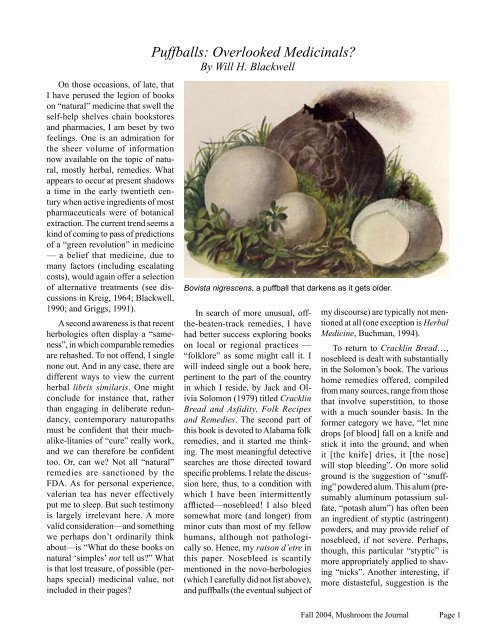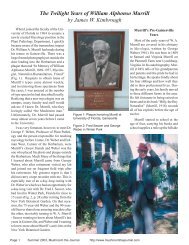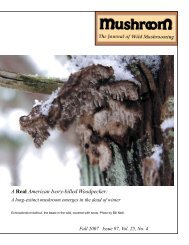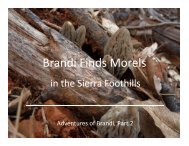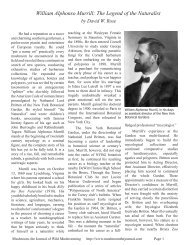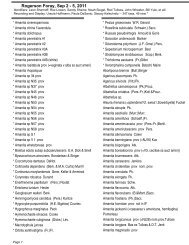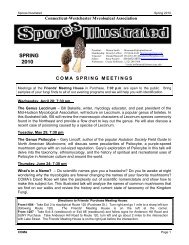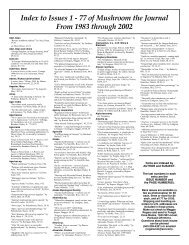Puffballs: Overlooked Medicinals? - Mushroom, the Journal of Wild ...
Puffballs: Overlooked Medicinals? - Mushroom, the Journal of Wild ...
Puffballs: Overlooked Medicinals? - Mushroom, the Journal of Wild ...
You also want an ePaper? Increase the reach of your titles
YUMPU automatically turns print PDFs into web optimized ePapers that Google loves.
On those occasions, <strong>of</strong> late, that<br />
I have perused <strong>the</strong> legion <strong>of</strong> books<br />
on “natural” medicine that swell <strong>the</strong><br />
self-help shelves chain bookstores<br />
and pharmacies, I am beset by two<br />
feelings. One is an admiration for<br />
<strong>the</strong> sheer volume <strong>of</strong> information<br />
now available on <strong>the</strong> topic <strong>of</strong> natural,<br />
mostly herbal, remedies. What<br />
appears to occur at present shadows<br />
a time in <strong>the</strong> early twentieth century<br />
when active ingredients <strong>of</strong> most<br />
pharmaceuticals were <strong>of</strong> botanical<br />
extraction. The current trend seems a<br />
kind <strong>of</strong> coming to pass <strong>of</strong> predictions<br />
<strong>of</strong> a “green revolution” in medicine<br />
— a belief that medicine, due to<br />
many factors (including escalating<br />
costs), would again <strong>of</strong>fer a selection<br />
<strong>of</strong> alternative treatments (see discussions<br />
in Kreig, 1964; Blackwell,<br />
1990; and Griggs, 1991).<br />
A second awareness is that recent<br />
herbologies <strong>of</strong>ten display a “sameness”,<br />
in which comparable remedies<br />
are rehashed. To not <strong>of</strong>fend, I single<br />
none out. And in any case, <strong>the</strong>re are<br />
different ways to view <strong>the</strong> current<br />
herbal libris similaris. One might<br />
conclude for instance that, ra<strong>the</strong>r<br />
than engaging in deliberate redundancy,<br />
contemporary naturopaths<br />
must be confident that <strong>the</strong>ir muchalike-litanies<br />
<strong>of</strong> “cure” really work,<br />
and we can <strong>the</strong>refore be confident<br />
too. Or, can we? Not all “natural”<br />
remedies are sanctioned by <strong>the</strong><br />
FDA. As for personal experience,<br />
valerian tea has never effectively<br />
put me to sleep. But such testimony<br />
is largely irrelevant here. A more<br />
valid consideration—and something<br />
we perhaps don’t ordinarily think<br />
about—is “What do <strong>the</strong>se books on<br />
natural ‘simples’ not tell us?” What<br />
is that lost treasure, <strong>of</strong> possible (perhaps<br />
special) medicinal value, not<br />
included in <strong>the</strong>ir pages?<br />
<strong>Puffballs</strong>: <strong>Overlooked</strong> <strong>Medicinals</strong>?<br />
By Will H. Blackwell<br />
Bovista nigrescens, a puffball that darkens as it gets older.<br />
In search <strong>of</strong> more unusual, <strong>of</strong>f<strong>the</strong>-beaten-track<br />
remedies, I have<br />
had better success exploring books<br />
on local or regional practices —<br />
“folklore” as some might call it. I<br />
will indeed single out a book here,<br />
pertinent to <strong>the</strong> part <strong>of</strong> <strong>the</strong> country<br />
in which I reside, by Jack and Olivia<br />
Solomon (1979) titled Cracklin<br />
Bread and Asfidity, Folk Recipes<br />
and Remedies. The second part <strong>of</strong><br />
this book is devoted to Alabama folk<br />
remedies, and it started me thinking.<br />
The most meaningful detective<br />
searches are those directed toward<br />
specific problems. I relate <strong>the</strong> discussion<br />
here, thus, to a condition with<br />
which I have been intermittently<br />
afflicted—nosebleed! I also bleed<br />
somewhat more (and longer) from<br />
minor cuts than most <strong>of</strong> my fellow<br />
humans, although not pathologically<br />
so. Hence, my raison d’etre in<br />
this paper. Nosebleed is scantily<br />
mentioned in <strong>the</strong> novo-herbologies<br />
(which I carefully did not list above),<br />
and puffballs (<strong>the</strong> eventual subject <strong>of</strong><br />
my discourse) are typically not mentioned<br />
at all (one exception is Herbal<br />
Medicine, Buchman, 1994).<br />
To return to Cracklin Bread…,<br />
nosebleed is dealt with substantially<br />
in <strong>the</strong> Solomon’s book. The various<br />
home remedies <strong>of</strong>fered, compiled<br />
from many sources, range from those<br />
that involve superstition, to those<br />
with a much sounder basis. In <strong>the</strong><br />
former category we have, “let nine<br />
drops [<strong>of</strong> blood] fall on a knife and<br />
stick it into <strong>the</strong> ground, and when<br />
it [<strong>the</strong> knife] dries, it [<strong>the</strong> nose]<br />
will stop bleeding”. On more solid<br />
ground is <strong>the</strong> suggestion <strong>of</strong> “snuffing”<br />
powdered alum. This alum (presumably<br />
aluminum potassium sulfate,<br />
“potash alum”) has <strong>of</strong>ten been<br />
an ingredient <strong>of</strong> styptic (astringent)<br />
powders, and may provide relief <strong>of</strong><br />
nosebleed, if not severe. Perhaps,<br />
though, this particular “styptic” is<br />
more appropriately applied to shaving<br />
“nicks”. Ano<strong>the</strong>r interesting, if<br />
more distasteful, suggestion is <strong>the</strong><br />
Fall 2004, <strong>Mushroom</strong> <strong>the</strong> <strong>Journal</strong> Page 1
The giant puffball, Calvatia gigantea.<br />
use <strong>of</strong> “soot and cobwebs to stop<br />
bleeding”; in o<strong>the</strong>r words, a bleeding<br />
nose (or wound) could be physically<br />
packed with such material to slow<br />
blood flow — sounds bad, but it just<br />
might help! The idea <strong>of</strong> physical<br />
packing <strong>of</strong> wounds, with spiderwebs<br />
for example, is pertinent to our<br />
discussion, and I will later tie this<br />
back in. Before moving on, though,<br />
I’m sure that o<strong>the</strong>r treatments for<br />
nosebleed — holding your head in<br />
a certain position, or putting an ice<br />
pack over your nose, or simply lying<br />
on your back — come to mind. But<br />
such considerations run somewhat<br />
away from <strong>the</strong> point.<br />
The point is, with bleeding problems<br />
(including cuts and abrasions)<br />
as a focus for investigation, what additional<br />
remedies might be unear<strong>the</strong>d<br />
with some bibliographic sleuthing?<br />
Are some remedies mycological?<br />
Ashley et al. (1976) reported, among<br />
folk medicines <strong>of</strong> <strong>the</strong> Mammoth Cave<br />
area <strong>of</strong> Kentucky, that application <strong>of</strong><br />
pulverized mushroom to a cut would<br />
be efficacious in efforts to halt bleeding.<br />
Ashley’s “mushroom” reference<br />
wasn’t specific, but one cannot<br />
rule out puffball usage in this case,<br />
since puffballs were loosely known<br />
(by some) as “mushrooms” (e.g.,<br />
“prairie mushrooms”, see Gilmore,<br />
1977). More explicitly, Coon (1980)<br />
discussed reports <strong>of</strong> a styptic effect<br />
<strong>of</strong> puffball spores when “dusted on<br />
wounds”. Coon drew some discussion<br />
from early English herbals<br />
such as those <strong>of</strong> Gerard and Fernie.<br />
Here, superstitious belief was interwoven<br />
with fact. Gerard reported,<br />
erroneously, that receiving a cloud<br />
<strong>of</strong> puffball spores in <strong>the</strong> eye could<br />
cause a kind <strong>of</strong> blindness, called<br />
“Poorblinde” (Findlay, 1982). Coon<br />
(1980) related his discussion as well<br />
to North American “Indian” herbal<br />
use. He considered <strong>the</strong> extensive use<br />
<strong>of</strong> puffballs by Native Americans<br />
unusual because, as Coon asserted<br />
anyway, “<strong>the</strong> Indians were generally<br />
afraid <strong>of</strong>…fungi”. The truth <strong>of</strong> this<br />
statement regarding “fear” is difficult<br />
to gauge, but is certainly not entirely<br />
accurate. Hutchens (1991), in Indian<br />
Herbalogy <strong>of</strong> North America, made<br />
note <strong>of</strong> Native American use <strong>of</strong> <strong>the</strong><br />
“Chaga” or “Birch <strong>Mushroom</strong>” (Inonotus<br />
obliquus), which is actually a<br />
bracket or polypore fungus. Swanton<br />
(1946) and Hudson (1976) alluded<br />
to limited usage <strong>of</strong> kinds <strong>of</strong> mushrooms<br />
(as food) among Indians <strong>of</strong> <strong>the</strong><br />
Sou<strong>the</strong>astern United States.<br />
But, back to puffballs, and bleeding<br />
(i.e., <strong>the</strong> stopping <strong>the</strong>re<strong>of</strong>). In an<br />
inquiry such as this, one must eventually<br />
consult “primary literature”, i.e.,<br />
trace information back to original<br />
reference sources. In researching<br />
information on puffballs I was fortunate<br />
to find <strong>the</strong> largely bibliographic,<br />
yet ethnographically oriented, survey<br />
by William R. Burk, <strong>of</strong> puffball usage<br />
among Native Americans (published<br />
in <strong>Journal</strong> <strong>of</strong> Ethnobiology, 1983).<br />
Although I was familiar with some<br />
sources (e.g., Gilmore, 1977, on uses<br />
<strong>of</strong> “plants” by Missouri River Region<br />
tribes; and Densmore, 1974, on plant<br />
use by <strong>the</strong> Chippewas), Burk covered<br />
a number <strong>of</strong> additional references<br />
(understandably, though, since no<br />
one can cover everything related to a<br />
topic, <strong>the</strong>re are still o<strong>the</strong>r references<br />
that could be brought to bear). In<br />
any case, it is clear from <strong>the</strong> surveys<br />
<strong>of</strong> Burk, Gilmore, and o<strong>the</strong>rs (e.g.,<br />
Vogel, 1970), that <strong>the</strong> majority <strong>of</strong><br />
Native American groups had little<br />
fear <strong>of</strong> fungi, if <strong>the</strong> fungus was a<br />
puffball! There were exceptions,<br />
however, as at least one native group<br />
referred to puffball powder (spores)<br />
as “devil’s snuff” (Burk, 1983;<br />
Page<br />
2<br />
Fall 2004, <strong>Mushroom</strong> <strong>the</strong> <strong>Journal</strong>
Schaechter, 1997). None<strong>the</strong>less, usage<br />
<strong>of</strong> puffballs by Native American<br />
tribes was widespread, including:<br />
Blackfoot, Cherokee, Chippewa,<br />
Dakota, Iroquois, Kiowa, Makah,<br />
Mohegan, Navajo, Ojibwe, Omaha,<br />
Paiute, Pawnee, Ponca, Potawatomi,<br />
Tewa and Zuni Indians.<br />
Native Americans used puffballs<br />
in numerous ways — as rattles,<br />
charms, o<strong>the</strong>r ancillary religious<br />
items, ornaments, dusting powders,<br />
poultices, and food in some instances.<br />
What ethnobiologists look for,<br />
in a broad occurrence <strong>of</strong> use <strong>of</strong> an<br />
item, is a common thread <strong>of</strong> usage,<br />
a particular use in which a majority<br />
<strong>of</strong> groups surveyed manifested<br />
similar practice. The “universal”<br />
use <strong>of</strong> puffballs was deciphered by<br />
Burk, and o<strong>the</strong>rs, as being that <strong>of</strong> a<br />
styptic or hemostatic (blood coagulating)<br />
agent — for treatment <strong>of</strong> cuts,<br />
wounds, abrasions, nosebleed, and<br />
<strong>the</strong> like. In certain cases, <strong>the</strong> Indian<br />
name for <strong>the</strong> puffball reflected its<br />
styptic use, or <strong>the</strong> stage <strong>of</strong> growth<br />
at which it was so applied (e.g.,<br />
<strong>the</strong> Pawnee name “Kaho rahik”—<br />
“kaho”, <strong>the</strong> name <strong>of</strong> <strong>the</strong> puffball, and<br />
“rahik”, meaning “old”, Gilmore,<br />
Earthstars, Geastrum quadrifidium<br />
Lycoperdon coelatum, a small<br />
pebbly puffball<br />
1977). The commonality <strong>of</strong> usage,<br />
by different tribes, imparts credence<br />
to <strong>the</strong> alleged medicinal value <strong>of</strong> an<br />
item, elevating it beyond <strong>the</strong> level <strong>of</strong><br />
superstition. There is no doubt that<br />
puffballs, used variously in younger<br />
and older stages, are effective in<br />
slowing or stopping unwanted blood<br />
flow. A striking example <strong>of</strong> a specific<br />
hemostatic use <strong>of</strong> puffballs (or <strong>the</strong>ir<br />
relatives, <strong>the</strong> earthstars) by disjunct<br />
groups <strong>of</strong> native Americans (Cherokee,<br />
Missouri River Indian Groups,<br />
Rocky Mountain Indian Groups) was<br />
<strong>the</strong> control <strong>of</strong> bleeding <strong>of</strong> <strong>the</strong> navels<br />
<strong>of</strong> babies, after severing <strong>the</strong> umbilicus<br />
(Hamel and Chiltoskey, 1975;<br />
Gilmore, 1977; Burk, 1983; Powell,<br />
1990). To continue an earlier point,<br />
several groups (e.g., Kwakiutls and<br />
Mohegans) made use <strong>of</strong> both puffball<br />
spores and spiderwebs as styptic<br />
agents (Vogel, 1970). There is, in<br />
fact, evidence that <strong>the</strong>se two hemostatic<br />
materials were sometimes used<br />
in consort (Burk, 1983).<br />
Native American use <strong>of</strong> puffballs<br />
as hemostatics is bolstered by similar<br />
use in o<strong>the</strong>r cultures. I previously<br />
mentioned descriptions <strong>of</strong> such use<br />
in English herbals. Keys (1976) reported<br />
comparable usage in Chinese<br />
herbology (for treatment <strong>of</strong> “hemorrhage<br />
<strong>of</strong> incised wounds”) — a use<br />
substantiated by Ooi (2001). Singh<br />
(1999) and Harsh et al. (1999) made<br />
note <strong>of</strong> hemostatic use <strong>of</strong> several<br />
different puffballs by indigenous<br />
peoples in India. One example<br />
from India, Bovista apedicellata<br />
(employed to treat wounds), is interesting<br />
etymologically: <strong>the</strong> local<br />
name for this puffball is “phoosh”.<br />
This name appears to be an instance<br />
where <strong>the</strong> sound <strong>of</strong> <strong>the</strong> word and its<br />
meaning (dust, powder blowing)<br />
are connected. If I remember from<br />
my now-long-ago English classes,<br />
this form <strong>of</strong> figurative language is<br />
onomatopoeia.<br />
Before waxing too literary, let’s<br />
return to puffballs and <strong>the</strong>ir spores.<br />
Given that such items are effective<br />
hemostatic (vulnerary, or wound<br />
dressing) agents, given that <strong>the</strong>y<br />
help stem blood flow, <strong>the</strong> question<br />
becomes, how do <strong>the</strong>y function in<br />
this way? What is <strong>the</strong> nature <strong>of</strong> <strong>the</strong><br />
styptic mechanism? Apparently,<br />
mere physical packing <strong>of</strong> wounds,<br />
directly related to spore numbers/total<br />
volume, is part <strong>of</strong> <strong>the</strong> answer. An<br />
astounding seven trillion spores were<br />
estimated to have been produced<br />
by a single giant puffball, Calvatia<br />
gigantea (see Ramsbottom, 1989).<br />
Fall 2004, <strong>Mushroom</strong> <strong>the</strong> <strong>Journal</strong> Page 3
A stalked puffball in <strong>the</strong> genus<br />
Tulostoma<br />
Dana Richter and Maria Beardslee,<br />
in <strong>the</strong> previous issue <strong>of</strong> <strong>Mushroom</strong><br />
<strong>the</strong> <strong>Journal</strong>, set <strong>the</strong> estimate even<br />
higher (at least eight trillion spores).<br />
In puffball species <strong>of</strong> lesser size,<br />
spore numbers are still high. More<br />
than four billion spores were calculated<br />
to have been generated by one<br />
Lycoperdon perlatum specimen; a<br />
single ejection (puff) <strong>of</strong> spores (due<br />
to a falling drop <strong>of</strong> water striking<br />
<strong>the</strong> peridium) from L. perlatum<br />
may contain as many as 15 million<br />
spores (Gregory, 1949). No fur<strong>the</strong>r<br />
calculation is required to realize that<br />
millions <strong>of</strong> absorbent spores might<br />
be laid into a wound in a single application.<br />
En masse, such spores are<br />
usually more than sufficient to slow<br />
blood flow or oozing, much in <strong>the</strong><br />
manner <strong>of</strong> styptic after-shave powder.<br />
But is <strong>the</strong>re more to <strong>the</strong> answer<br />
than just physical packing (and absorption)?<br />
Is a chemical mechanism<br />
at work too? Possibly, but here <strong>the</strong><br />
answer gets complicated.<br />
A wide variety <strong>of</strong> biologically<br />
active chemicals have been isolated<br />
from puffballs, with names like lycoperdin,<br />
lycoperdic acid, calvatic acid,<br />
and calvacin. Indeed, calvacin was<br />
one <strong>of</strong> <strong>the</strong> first glycoproteins in <strong>the</strong><br />
thundering herd that are now being<br />
touted as anti-tumor agents, as evidenced<br />
in Everett S. Beneke’s 1962<br />
presidential address to <strong>the</strong> Mycological<br />
Society <strong>of</strong> America: “Calvatia,<br />
Calvacin and Cancer”.<br />
A variety <strong>of</strong> puffballs, earthstars<br />
and earthballs have been used medicinally<br />
by Native Americans, styptic<br />
use being predominant. <strong>Puffballs</strong><br />
have been used similarly by people<br />
<strong>of</strong> o<strong>the</strong>r cultures in North America:<br />
Pennsylvania Germans made use <strong>of</strong><br />
powdered puffballs as hemostatics<br />
(Brendle and Unger, 1935; Vogel,<br />
1970); and <strong>the</strong> use <strong>of</strong> puffballs in<br />
packing nosebleeds and bleeding<br />
hemorrhoids is known from Appalachian<br />
folk medicine (Powell, 1990).<br />
Three genera <strong>of</strong> puffballs have already<br />
been mentioned in my discussion:<br />
Calvatia, Lycoperdon and Bovista.<br />
Lycoperdons are distinguished<br />
from Calvatias by characteristics <strong>of</strong><br />
<strong>the</strong>ir skin (or peridium): Lycoperdons<br />
have a specific apical opening<br />
through which <strong>the</strong>y discharge <strong>the</strong>ir<br />
spores, whereas Calvatias split<br />
apart entirely; and Lycoperdons<br />
<strong>of</strong>ten have an ornamented (spiny or<br />
warty) outer layer to <strong>the</strong>ir skin, while<br />
Calvatias are smooth. Bovistas are<br />
tumbleweeds <strong>of</strong> <strong>the</strong> fungus world,<br />
detaching from <strong>the</strong>ir small stalk and<br />
being rolled by <strong>the</strong> wind to disperse<br />
<strong>the</strong>ir spores.<br />
The desert stalked puffball, Battarrea<br />
phalloides, is also used (as a<br />
poultice) by Nevada Indian tribes<br />
for treatment (reduction) <strong>of</strong> sores,<br />
swellings and burns (Burk, 1983;<br />
Powell, 1990). An earthstar, Astraeus<br />
hygrometricus (<strong>the</strong> “barometer”<br />
or “water-measure” earthstar), may<br />
also be added to <strong>the</strong> “styptic list”,<br />
given its use in administering to<br />
navels <strong>of</strong> <strong>the</strong> newborn (Hamel and<br />
Chiltoskey, 1975). Several styptic<br />
puffballs and relatives are illustrated,<br />
Figures 1−5.<br />
The enumeration <strong>of</strong> taxa in <strong>the</strong><br />
above paragraph is not to suggest<br />
that o<strong>the</strong>r species and genera <strong>of</strong><br />
puffballs (and <strong>the</strong>ir “allies”) are not<br />
effective hemostatic agents; o<strong>the</strong>r<br />
puffball taxa have doubtless been<br />
so employed, at one time or ano<strong>the</strong>r.<br />
This supports a point made by Burk<br />
(1983), who stated that <strong>the</strong> medical<br />
and paramedical uses <strong>of</strong> puffballs<br />
(and relatives) should be fur<strong>the</strong>r<br />
investigated. I would like to add my<br />
encouragement to such investigations.<br />
People obviously find puffballs<br />
fascinating (see back cover <strong>of</strong> Issues<br />
78 and 80, 2003, <strong>of</strong> <strong>Mushroom</strong>, The<br />
<strong>Journal</strong>…). And <strong>the</strong>re is no doubt<br />
that masses <strong>of</strong> puffball spores will<br />
stop <strong>the</strong> bleeding <strong>of</strong> a cut <strong>of</strong> modest<br />
dimension. As I see it, <strong>the</strong> main question<br />
remaining is “Which substances<br />
in <strong>the</strong>se fungi contribute to <strong>the</strong>ir styptic<br />
properties?” Such investigations,<br />
and <strong>the</strong> eventual answering <strong>of</strong> <strong>the</strong><br />
question, may involve fur<strong>the</strong>r chemical<br />
extraction and determination.<br />
A chemical work-up would likely<br />
need to be followed by in vitro (test<br />
tube) blood coagulation experiments.<br />
Preliminary studies, though, might<br />
need only involve comparisons <strong>of</strong><br />
<strong>the</strong> effects <strong>of</strong> puffball spores versus<br />
various types <strong>of</strong> “comparable” sterile<br />
powders. So, is anyone up for this<br />
particular challenge? The potential<br />
contribution <strong>of</strong> this kind <strong>of</strong> work<br />
to <strong>the</strong> understanding <strong>of</strong> “medicinal<br />
fungi” could be quite significant. So,<br />
who are <strong>the</strong> inveterate fungal chemists<br />
among us? Speaking literally and<br />
figuratively, who might wish to give<br />
blood for such a project?<br />
Page<br />
4<br />
Fall 2004, <strong>Mushroom</strong> <strong>the</strong> <strong>Journal</strong>
References<br />
Ashley, O. et al., 1976. Folk<br />
medicine <strong>of</strong> <strong>the</strong> Mammoth Cave area.<br />
Mammoth Cave Folklore Project,<br />
Kentucky.<br />
Beneke, E.S., 1963. “Calvatia,<br />
calvacin and cancer.” Mycologia<br />
55:257-270.<br />
Blackwell, W.H., 1990. Poisonous<br />
and medicinal plants. Prentice<br />
Hall, Englewood Cliffs, New Jersey.<br />
Brendle, T.R. and C.W. Unger,<br />
1935. Folk medicine <strong>of</strong> <strong>the</strong> Pennsylvania<br />
Germans. Pennsylvania German<br />
Society, Norristown, PA.<br />
Buckman, D.D., 1994. Herbal<br />
medicine: The natural way to get<br />
well and stay well. Wings Books,<br />
New York and Avenel, New Jersey.<br />
Burk, W.R., 1983. “Puffball usages<br />
among North American Indians.”<br />
<strong>Journal</strong> <strong>of</strong> Ethnobiology 3:55-62.<br />
Coon, N., 1980. Using wild and<br />
wayside plants. Dover Publications,<br />
New York. (Originally published as<br />
“Using wayside plants’, 1957, by<br />
Hearthside Press)<br />
Densmore, F., 1974. How Indians<br />
use wild plants for food, medicine<br />
and crafts. Dover Publications, NY.<br />
(Published, 1928, as “Uses <strong>of</strong> plants<br />
by <strong>the</strong> Chippewa Indians”)<br />
Findlay, W.P.K., 1982. Fungi:<br />
folklore, fiction & fact. Richmond<br />
Publ., Surrey.<br />
Gilmore, M.R., 1977. Uses <strong>of</strong><br />
plants by <strong>the</strong> Indians <strong>of</strong> <strong>the</strong> Missouri<br />
River region. University <strong>of</strong> Nebraska<br />
Press, Lincoln and London, UK.<br />
(Enlarged paperback printing, with<br />
additional drawings, 1991; originally<br />
published, 1919, U.S. Gov. Printing<br />
Office).<br />
Gregory, P.H., 1949. “The operation<br />
<strong>of</strong> <strong>the</strong> puff-ball mechanism <strong>of</strong><br />
Lycoperdon perlatum by raindrops<br />
shown by ultra-high-speed Schlieren<br />
cinematography.” Transactions<br />
<strong>of</strong> <strong>the</strong> British Mycological Society<br />
32:11-15.<br />
Griggs, B., 1991. Green pharmacy:<br />
The history and evolution <strong>of</strong><br />
western herbal medicine. Healing<br />
Arts Press, Rochester, Vermont.<br />
Hamel, P.B. and M.U. Chiltoskey,<br />
1975. Cherokee plants, and <strong>the</strong>ir<br />
uses—a 400 year history. Published<br />
by <strong>the</strong> authors.<br />
Harsh, N.S.K., B.K. Rai and V.K.<br />
Soni, 1999. “Some ethnomycological<br />
studies from Madhya Pradesh,<br />
India.” Pages 19-31 in Sing, J. and<br />
K.R. Aneja (eds.), From ethnomycology<br />
to fungal biotechnology. Kluwer,<br />
and Plenum Publishers, New York.<br />
Hudson, C., 1976. The Sou<strong>the</strong>astern<br />
Indians. Univ. Tennessee Press,<br />
Knoxville.<br />
Hutchens, A.R., 1991. Indian<br />
herbalogy <strong>of</strong> North America. Shambhala<br />
Publications, Boston and London.<br />
(First published, 1973)<br />
Keys, J.D., 1976. Chinese herbs:<br />
<strong>the</strong>ir botany, chemistry, and pharmacodynamics.<br />
Charles E. Tuttle<br />
Company, Rutland, Vermont, and<br />
Tokyo, Japan.<br />
Kreig, M.B., 1964. Green medicine.<br />
Rand McNally, Chicago.<br />
Ooi, V.E.C., 2001. “Higher fungi<br />
in traditional Chinese medicine.”<br />
Pages 191-222 in Pointing, S.B. and<br />
K.D. Hyde (eds.), Bio-exploitation <strong>of</strong><br />
filamentous fungi. Fungal Diversity<br />
Press, Hong Kong, China.<br />
Powell, M.J., 1990. “Poisonous<br />
and medicinal fungi.” Pages 71-110<br />
in Blackwell, W.H., Poisonous and<br />
medicinal plants. Prentice Hall,<br />
Englewood Cliffs, New Jersey.<br />
Ramsbottom, J., 1989. <strong>Mushroom</strong>s<br />
and toadstools: A study <strong>of</strong><br />
<strong>the</strong> activities <strong>of</strong> fungi. Bloomsbury<br />
Books, London. (Collins New Naturalist<br />
Series)<br />
Richter, D.L. and M.P. Beardslee,<br />
2004. “Probing <strong>the</strong> infinitesimal: The<br />
number <strong>of</strong> spores in a giant puffball.”<br />
<strong>Mushroom</strong>, The <strong>Journal</strong> <strong>of</strong> <strong>Wild</strong><br />
<strong>Mushroom</strong>ing 22(3):6-7.<br />
Schaechter, E., 1997. In <strong>the</strong> company<br />
<strong>of</strong> mushrooms: a biologist’s<br />
tale. Harvard University Press, Cambridge,<br />
MA and London, UK.<br />
Singh, J., 1999. “Ethnomycology<br />
and folk remedies: Fact and fiction.”<br />
Pages 11-17 in Singh, J. and K. R.<br />
Aneja (eds.), From ethnomycology<br />
to fungal biotechnology. Kluwer, and<br />
Plenum Publishers, New York.<br />
Solomon, J. and O.P. Solomon,<br />
1979. Cracklin bread and asfidity,<br />
folk recipes and remedies. The University<br />
<strong>of</strong> Alabama Press, Tuscaloosa<br />
and London.<br />
Swanton, J.R., 1946. The Indians<br />
<strong>of</strong> <strong>the</strong> Sou<strong>the</strong>astern United States.<br />
Smithsonian Institution Press, Washington,<br />
D.C. (reprinted 1979)<br />
Vogel, V.J., 1970. American<br />
Indian Medicine. University <strong>of</strong><br />
Oklahoma Press, Norman, OK and<br />
London, UK.<br />
Fall 2004, <strong>Mushroom</strong> <strong>the</strong> <strong>Journal</strong> Page 5


